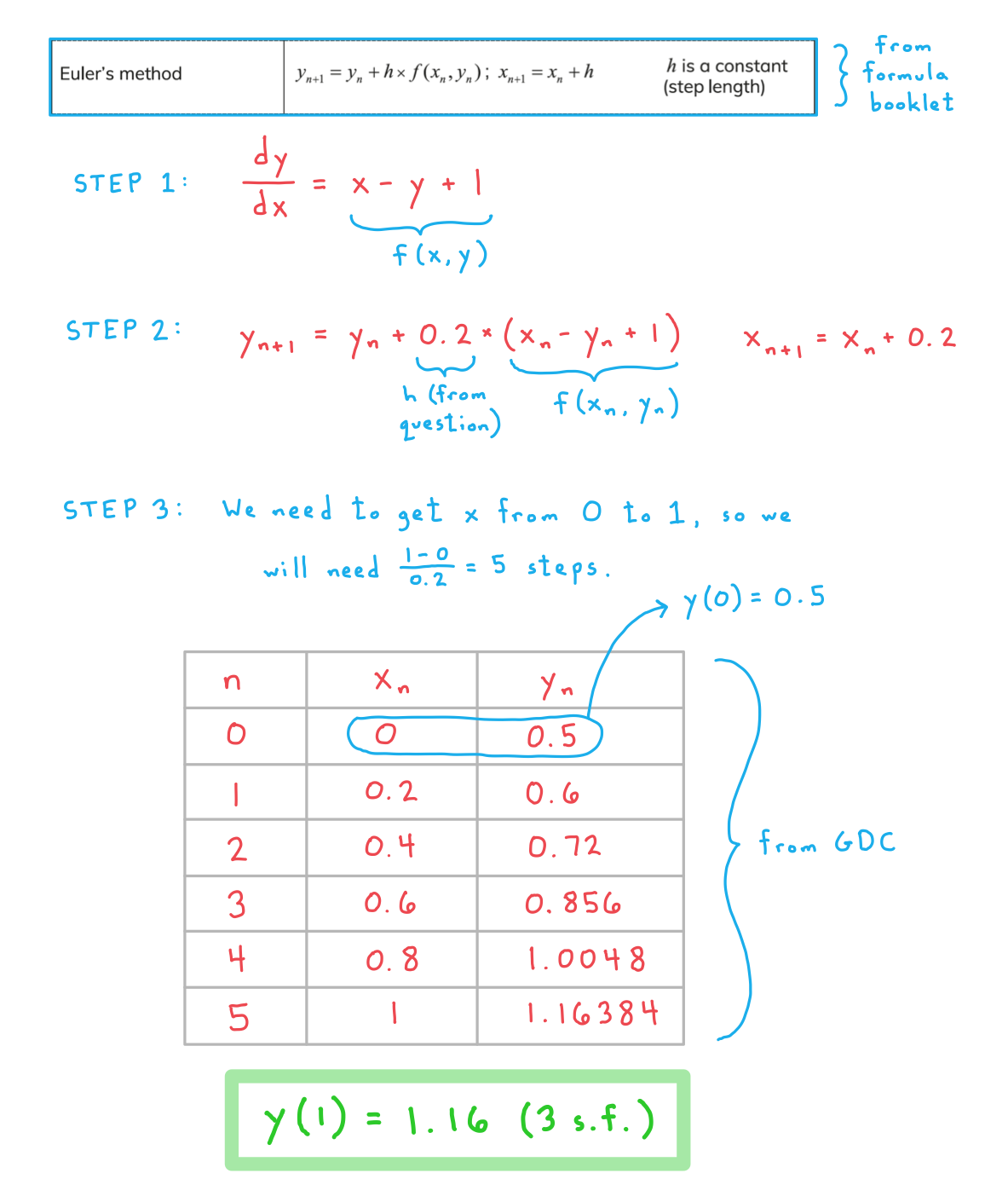First Order Differential Equations
What is a differential equation?
- A differential equation is simply an equation that contains derivatives
- For example
is a differential equation
- And so is
What is a first order differential equation?
- A first order differential equation is a differential equation that contains first derivatives but no second (or higher) derivatives
- For example
is a first order differential equation
- But
is not a first order differential equation, because it contains the second derivative
Wait – haven’t I seen first order differential equations before?
- Yes you have!
- For example
is also a first order differential equation, because it contains a first derivative and no second (or higher) derivatives
- But for that equation you can just integrate to find the solution y = x3 + c (where c is a constant of integration)
- In this section of the course you learn how to solve differential equations that can’t just be solved right away by integrating
Euler’s Method: First Order
What is Euler’s method?
- Euler’s method is a numerical method for finding approximate solutions to differential equations
- It treats the derivatives in the equation as being constant over short ‘steps’
- The accuracy of the Euler’s Method approximation can be improved by making the step sizes smaller
How do I use Euler’s method with a first order differential equation?
- STEP 1: Make sure your differential equation is in
form
- STEP 2: Write down the recursion equations using the formulae
and
from the exam formula booklet
- h in those equations is the step size
- the exam question will usually tell you the correct value of h to use
- STEP 3: Use the recursion feature on your GDC to calculate the Euler’s method approximation over the correct number of steps
- the values for
and
will come from the boundary conditions given in the question
Exam Tip
- Be careful with letters – in the equations in the exam, and in your GDC’s recursion calculator, the variables may not be x and y
- If an exam question asks you how to improve an Euler’s method approximation, the answer will almost always have to do with decreasing the step size!
Worked Example
Consider the differential equation with the boundary condition
.
a)
Apply Euler’s method with a step size of format('truetype')%3Bfont-weight%3Anormal%3Bfont-style%3Anormal%3B%7D%3C%2Fstyle%3E%3C%2Fdefs%3E%3Ctext%20font-family%3D%22Times%20New%20Roman%22%20font-size%3D%2218%22%20font-style%3D%22italic%22%20text-anchor%3D%22middle%22%20x%3D%224.5%22%20y%3D%2216%22%3Eh%3C%2Ftext%3E%3Ctext%20font-family%3D%22math11824c643d1feb4da18b28ed527%22%20font-size%3D%2216%22%20text-anchor%3D%22middle%22%20x%3D%2218.5%22%20y%3D%2216%22%3E%3D%3C%2Ftext%3E%3Ctext%20font-family%3D%22Times%20New%20Roman%22%20font-size%3D%2218%22%20text-anchor%3D%22middle%22%20x%3D%2231.5%22%20y%3D%2216%22%3E0%3C%2Ftext%3E%3Ctext%20font-family%3D%22math11824c643d1feb4da18b28ed527%22%20font-size%3D%2216%22%20text-anchor%3D%22middle%22%20x%3D%2238.5%22%20y%3D%2216%22%3E.%3C%2Ftext%3E%3Ctext%20font-family%3D%22Times%20New%20Roman%22%20font-size%3D%2218%22%20text-anchor%3D%22middle%22%20x%3D%2245.5%22%20y%3D%2216%22%3E2%3C%2Ftext%3E%3C%2Fsvg%3E) to approximate the solution to the differential equation at
to approximate the solution to the differential equation at format('truetype')%3Bfont-weight%3Anormal%3Bfont-style%3Anormal%3B%7D%3C%2Fstyle%3E%3C%2Fdefs%3E%3Ctext%20font-family%3D%22Times%20New%20Roman%22%20font-size%3D%2218%22%20font-style%3D%22italic%22%20text-anchor%3D%22middle%22%20x%3D%224.5%22%20y%3D%2216%22%3Ex%3C%2Ftext%3E%3Ctext%20font-family%3D%22math17f39f8317fbdb1988ef4c628eb%22%20font-size%3D%2216%22%20text-anchor%3D%22middle%22%20x%3D%2218.5%22%20y%3D%2216%22%3E%3D%3C%2Ftext%3E%3Ctext%20font-family%3D%22Times%20New%20Roman%22%20font-size%3D%2218%22%20text-anchor%3D%22middle%22%20x%3D%2231.5%22%20y%3D%2216%22%3E1%3C%2Ftext%3E%3C%2Fsvg%3E) .
.

b)
Explain how the accuracy of the approximation in part (a) could be improved.

